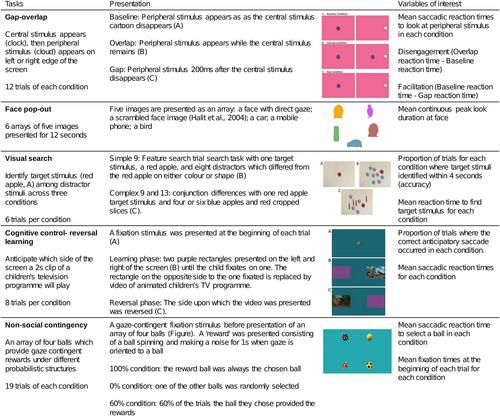Attentional development is altered in toddlers with congenital heart disease
Abstract
Background
Congenital Heart Disease (CHD) is the most common congenital abnormality. Survival rates are over 90%, however infants with CHD remain at high risk of attention and executive function impairments. These abilities are difficult to assess in toddlers because clinical assessments rely on language abilities which are commonly delayed in CHD. Our aim was to characterise visual attention in toddlers with CHD compared to controls and identify associations with parent-rated effortful control.
Methods
Thirty toddlers with CHD (19 male, median (IQR) age at assessment 22.2 (22–23.1) months) and 66 controls from the developing human connectome project (36 male, age at assessment 22 (21.5–23.8) months) using eye-tracking tasks designed to assess multiple components of visual attention. Analyses of co-variance and regressions were used to identify differences between groups and relationships between gaze behaviours and parent-rated effortful control.
Results
Toddlers with CHD were less accurate when switching behaviours (set-shifting) [median (IQR) 79%, (28–100)] compared to controls [100% (86–100), pFDR = 0.032], with worse accuracy associated with lower parent-rated effortful control in CHD but not controls (interaction pFDR = 0.028). Reaction times were slower during selective [CHD 1243 ms (986–1786), controls 1065 ms (0851–1397), pFDR<0.001] and exogenous attention tasks [CHD 312 ms (279–358), control 289 (249–331), (pFDR = 0.032) and endogenous attention was less mature (prolonged looks at facial stimuli CHD 670 ms (518–885), control 500 ms (250–625), (pFDR = 0.006). These results were unrelated to differences in cognition or socioeconomic status. In contrast, the allocation of attentional resources was preserved in CHD.
Conclusions
We identified a profile of altered attention and early executive functioning development in CHD. Eye-tracking may provide clinically feasible, early objective measures of attention and executive function development in CHD.



 求助内容:
求助内容: 应助结果提醒方式:
应助结果提醒方式:


